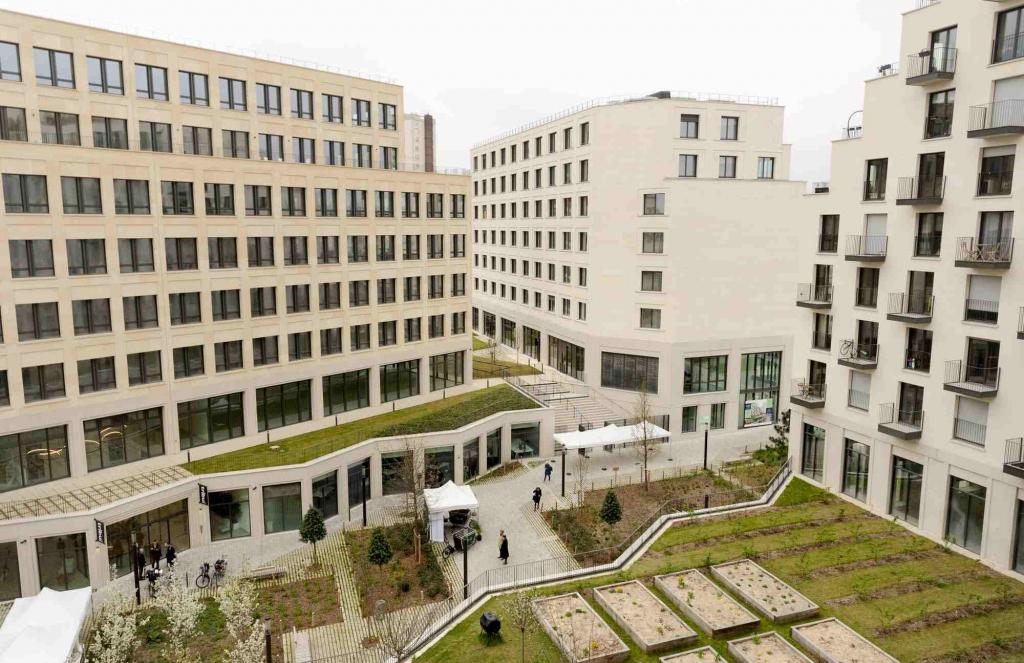Thessaloniki gets ready for its metro launch in November
The underground rapid transit lines have been under construction for almost two decades due to various project delays
 TheMayor.EU logo
TheMayor.EU logo 
Residents will also have access to garden plots where they can cultivate vegetables, Source: Ville de Paris/ Jean-Baptiste Gurliat
It’s tiny, but it’s also a step in the right direction and a possible model to replicate
Last week saw the official inauguration of what has been dubbed Paris’ first zero-carbon neighbourhood, located in the 19th arrondissement. The new residential complex, consisting of four buildings is called Îlot fertile (Fertile Isle) and despite its small size contains housing units, hotels, shops, offices and sports facilities, and quite remarkably – no parking spaces, at all.
The Fertile Isle is located on what used to be a degraded industrial space located between railway tracks and occupying a surface of 1.3 hectares. The small area of the quartier, however, also demonstrates that it is possible to create viable and multi-functional urban spaces in line with sustainable standards. 15-minute city? This could even bring about a 2-minute city concept.
Every facet of the neighbourhood conforms to sustainable and low-carbon practices.
The layout and design of the buildings have been carefully considered to limit energy requirements for heating, cooling and lighting as much as possible. On-site energy production is planned with bio-solar roofs of 1,000 m2 of photovoltaic panels, naturally cooled by the various plants also present on the roofs.
The construction itself used locally sourced materials or low-carbon concrete. All of the buildings are equipped with an innovative heat recovery system. Pumps capture the heat from gray water (wastewater from showers or dishwashers) in order to transform it into energy to supply the hot water networks. Once cold, this same wastewater will pass under the pedestrian walkway to join the chilled water loop used to cool the offices.
Cars have not been included in the mobility plans in any way. Instead, a soft mobility track connects the buildings to the nearby RER E station of regional trains, as well as to the tram station. The track itself will be the property of the municipality.
In addition, with its public garden, its bio-solar vegetated roofs, its planted terraces and its vegetable gardens shared with almost 30 fruit trees, the Fertile Isle offers a habitat for the local flora and fauna.
Insect hotels, bat houses on the roof and even a dry stone wall to accommodate lizards have been installed. Birdhouses are integrated into the facades. For swifts, in particular, birds which refuse to settle in unfamiliar habitats, dedicated soundtracks were released just before the mating season to lure them into the nest boxes.
To meet its carbon commitments to the City of Paris, Linkcity (the property developer) has already planned preventive monitoring of the various buildings, in particular for monitoring consumption and the operation of heat pumps.
For ten years, the developer undertakes to follow the life of the district and testify to the City whether the commitments in terms of social integration and sustainable development are being followed.

The underground rapid transit lines have been under construction for almost two decades due to various project delays

Now you can get your wine in Talence by paying directly in Bitcoin

That’s because the state has to spend money on updating the railway infrastructure rather than subsidizing the cost of the popular pass

Rethinking renewable energy sources for the urban landscape

The examples, compiled by Beyond Fossil Fuels, can inform and inspire communities and entrepreneurs that still feel trepidation at the prospect of energy transition

Now you can get your wine in Talence by paying directly in Bitcoin

The 10th European Conference on Sustainable Cities and Towns (ESCT) sets the stage for stronger cooperation between the EU, national and local level to fast track Europe's transition to climate neutrality.

At least, that’s the promise made by the mayor of Paris, Anne Hidalgo

The underground rapid transit lines have been under construction for almost two decades due to various project delays

At least, that’s the promise made by the mayor of Paris, Anne Hidalgo

Hostal de Pinós is located in the geographical centre of the autonomous region

Despite its church-y name, the district has long been known as the hangout spot for the artsy crowds

Urban dwellers across the EU are having a say in making their surroundings friendlier to people and the environment.

Forests in the EU can help green the European construction industry and bolster a continent-wide push for architectural improvements.

Apply by 10 November and do your part for the transformation of European public spaces

An interview with the Mayor of a Polish city that seeks to reinvent itself

An interview with the newly elected ICLEI President and Mayor of Malmö

A conversation with the Mayor of Lisbon about the spirit and dimensions of innovation present in the Portuguese capital














